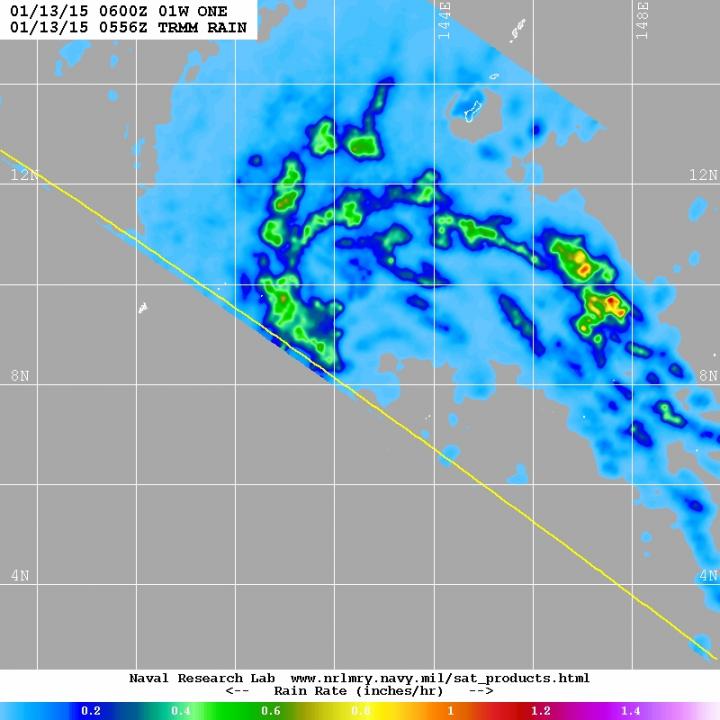First Northwestern Pacific tropical depression has moderate rainfall

The TRMM satellite passed over Tropical Depression 1W on Jan. 13, 2015 at 12:56 a.m. EST and saw two large broken bands of thunderstorms north of the center where rain was falling at a rate of 1 inch to 1.2 inches (25 to 20 mm) per hour. Credit: NASA/JAXA/NRL
The Tropical Rainfall Measuring Mission or TRMM satellite is managed by both NASA and the Japan Aerospace Exploration Agency called JAXA.
TRMM can measure the rate in which rain is falling from its orbit over the Earth's tropics. When it passed over Tropical Depression 1W (TD1W) on January 13 at 0556 UTC (12:56 a.m. EST) data showed two large broken bands of thunderstorms north of the center of circulation that contained moderate to heavy rainfall where rain was falling at a rate of 1 inch to 1.2 inches (25 to 20 mm) per hour.
The bulk of rainfall was occurring over the west-northwestern quadrant.
On Jan. 13 at 1500 UTC (10 a.m. EST) TD1W had maximum sustained winds near 25 knots (28.7 mph/46.3 kph). It was located about 222 nautical miles (255.5 miles/411.1 km) east of Yap, near 8.9 north latitude and 141.8 east longitude. It was moving to the west-northwest at 8 knots (9.2 mph/14.8 kph).
The Joint Typhoon Warning Center expects TD1W to move in a west-northwesterly direction and intensify to tropical storm status on approach to the east central Philippines by January 17.
###
Media Contact
All latest news from the category: Earth Sciences
Earth Sciences (also referred to as Geosciences), which deals with basic issues surrounding our planet, plays a vital role in the area of energy and raw materials supply.
Earth Sciences comprises subjects such as geology, geography, geological informatics, paleontology, mineralogy, petrography, crystallography, geophysics, geodesy, glaciology, cartography, photogrammetry, meteorology and seismology, early-warning systems, earthquake research and polar research.
Newest articles

High-energy-density aqueous battery based on halogen multi-electron transfer
Traditional non-aqueous lithium-ion batteries have a high energy density, but their safety is compromised due to the flammable organic electrolytes they utilize. Aqueous batteries use water as the solvent for…

First-ever combined heart pump and pig kidney transplant
…gives new hope to patient with terminal illness. Surgeons at NYU Langone Health performed the first-ever combined mechanical heart pump and gene-edited pig kidney transplant surgery in a 54-year-old woman…

Biophysics: Testing how well biomarkers work
LMU researchers have developed a method to determine how reliably target proteins can be labeled using super-resolution fluorescence microscopy. Modern microscopy techniques make it possible to examine the inner workings…





















